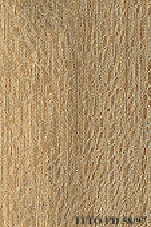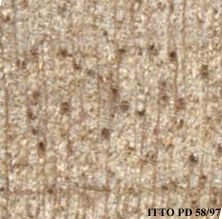
LUPUNA (Chorisia integrifolia)
Trade Name
Lupuna
Scientific Name
Chorisia integrifolia Ulbr.
Family
BOMBACACEAE
Common Names
Paneira (Uruguay); Zamuhu (Paraguay); Toborochi (Bolivia); Paneira (Brazil); Barriguda (Brazil); Yuchan (Argentina); Paneiro (Argentina); Lupuna (Peru)
Description Of The Tree
Botanical Description
Chorisia trees are massive, reaching heights of 40 m. The boles are cylindrical, with diameters ranging from 120 to 150 cm or more. They usually present 4 to 6 well developed buttresses.
Natural Habitat
Chorisia are pioneer trees, found mostly in secondary forests, close to rivers and water courses.
Natural Distribution
The Chorisia genus is reported to be well distributed all over tropical South America.
Wood Identification
Anatomic Description Of Wood
Wood diffuse porous. Vessels solitary and in short radial multiples. Tangential diameter of vessel lumina 200 micras or more (large). Tyloses common. Vessels per mm2 less than 6 (rare). Simple perforation plates. Vessel-ray pits coarse in marginal rows. Occasion Axial parenchyma in marginal or in seemingly marginal bands. Apotracheal axial parenchyma diffuse and/or diffuse in aggregates. Axial parenchyma storied. Prismatic crystals in non-chambered axial parenchyma cells. Occasionally prismatic crystals in non-chambe Rays less than 4 per mm (rare). Occasionally larger rays width 0. 1 mm or more and 2 mm or more in height. Rays non-storied. Larger rays more than 4 seriate. Prismatic crystals in the ray cells. Heterogeneous rays and/or multiseriate heterogeneous rays. Body ray Fibers with simple to minutely bordered pits.
-
 Wood Macro Photo Radial Plane
Wood Macro Photo Radial Plane
-
 Wood Micro Photo Of Transversal Section
Wood Micro Photo Of Transversal Section
Availability
Cites Status
Unrestricted
General Wood Description
Odor
It has no discernible odor or taste.
Color
The wood is white color.
COLOR INDEX (1=Black, 7=Light yellow,white)
5
Grain
The grain is mostly straight or slightly interlocked.
Texture
Texture is described as coarse.
Natural durability index (1= Very high durability, 7=Vey low durability)
5
Wood Physical Properties
Basic Density or Specific Gravity (O.D. weight/vol. green) (g/cm³)
0.28
Air-dry Density (Weight and volume at 12%MC) (g/cm³)
0.30
Total shrinkage Tangential (Saturated to 0%MC) (%)
6.5
Total shrinkage Radial (Saturated to 0%MC) (%)
2.4
Dimensional stability ratio (Total Tangential Shrinkage %/Total Radial Shrinkage %)
2.7
Wood Chemical Properties
Wood Mechanical Properties
Bending Strength (MOR),12%MC (kgf/cm²)
365
Compression parallel to fiber 12%MC (kgf/cm²)
176
Workability
Sawing
Sawing of this species is reportedly easy.
Rotary Veneer Cutting
This species is interesting for rotary peeling.
Sliced Veneer
This species is interesting for rotary peeling.
Blunting Effect
It has a slight blunting effect on the cutting tools.
Planing
Planing operations are rather easy.
Moulding
Molding of this species is reported to be easy.
Boring
This species is easy to bore.
REFERENCED USES
End Uses Summary
PLYWOOD AND VENEER, cores
Panels, Veneers
- 25 - Directory of Timber Trade Malaysia
Cores
- 27 - Embassy of Brazil in Japan
Please Provide Information To View Producer Information